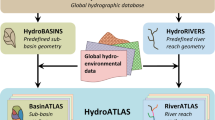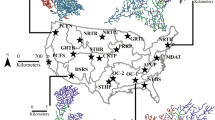Abstract
Evolutionary improvements in Geographic Information Systems (GIS) now routinely allow the management and mapping of spatial-temporal information. In response, the development of statistical models to combine information of different types and spatial support is of vital importance to environmental science. In this paper we develop a hierarchical spatial statistical model for environmental indicators of stream and river systems in the United States Mid-Atlantic Region by combining information from separate monitoring surveys, available contextual information on hydrologic units and remote sensing information. These models are used to estimate the indicators throughout the riverine system based on information from multiple sources and aggregate scales. The analysis is based on information underlying the Landscape Atlas of the mid-Atlantic region produced by the US Environmental Monitoring and Assessment Program (EMAP). We also combine information from two overlapping separate monitoring surveys, the EMAP Stream and River Survey and the Maryland Biological Streams Survey. We present a general framework for comparative distributional analysis based on the concept of a relative spatial distribution. As an application, the spatial model is used to predict spatial distributions and relative spatial distributions for a watershed.
Similar content being viewed by others
References
Anselin L and Florax R (1995). New directions is spatial econometrics. Springer-Verlag, Berlin
Bernhardt AD, Morris M and Handcock MS (1995). Women’s gains or men’s losses? A closer look at the shrinking gender gap in earnings. Am J Sociol 101: 302–328
Besag J (1974). Spatial interaction and the statistical analysis of lattice systems (with discussion). J Roy Stat Soc B 36: 192–236
Besag J (1975). Statistical analysis of non-lattice data. The Statistician 24: 179–195
Besag J (1989a). A candidate’s formula: a curious result in Bayesian prediction. Biometrika 76: 183–183
Besag J (1989b). Towards Bayesian image analysis. J Appl Stat 16: 395–407
Besag J and Kooperberg C (1995). On conditional and intrinsic autoregression. Biometrika 82: 733–746
Besag J, York J and Molliè A (1991). Bayesian Image Restoration, with two applications is spatial statistics (with discussion). Ann Inst Stat Mathemat 43: 1–59
Besag J and Higdon D (1999). Bayesian analysis of agricultural field trials (with discussion). J Roy Stat Soc B 61: 691–746
Bernardinelli L and Montomoli C (1992). Empirical Bayes versus fully Bayesian analysis of geographical variation in disease risk. Stat Med 11: 983–1007
Best NG, Ickstadt K, Wolpert RL (1998) Spatial Poisson regression for health and exposure data measured at disparate resolutions. Discussion paper, 98-36, Institute of Decision Sciences, Duke University
Butler RJ and McDonald JB (1987). Interdistributional Income Inequality. J Busi Econ Stat 5: 13–18
Cox LH and Piegorsch WW (1996). Combining environmental information. I: Environmental monitoring, measurement and assessment. Environmetrics 7: 299–308
Cox LH (1998) Workshop: statistical methods for combining environmental information. In: Nychka D, Piegorsch WW, Cox LH (eds) Case studies in environmental statistics, 143–158. Lecture Notes in Statistics, 132. Springer-Verlag
Cressie NAC (1993). Statistics for spatial data. Wiley, New York
Cressie NAC (1995). Bayesian smoothing of rates in small geographic areas. J Region Sci 35: 659–673
Cwik J and Mielniczuk J (1989). Estimating density ratios with application to discriminant analysis. Commun Stat 18: 3057–3069
Cwik J and Mielniczuk J (1993). Data-dependent bandwidth choice for a grade density kernel estimate. Stat Probabil Lett 16: 397–405
Dewald T, Olsen M (1994) The EPA reach file: A national spatial data resource. U.S. Environmental Protection Agency, Office of Water
Ecker MD and Gelfand AE (1997). Bayesian variogram modeling for an isotropic process. J Agric Biol Environ Stat 4: 347–369
Fausch KD, Lyons J, Karr JR, Angermeier PL (1990) Fish communities as indicators of environmental degradation. In: Adams SM (ed) Biological Indicators of Stress in Fish, 123–144. American Fisheries Society Symposium 8. Bethesda, Maryland
Gelman A, Carlin JB, Stern HS and Rubin DB (2003). Bayesian Data Analysis. Chapman and Hall, London
Handcock MS (1994). Discussion of “Epidemics: Models and Data” by D. Mollison, V. Isham and B. Grenfell (1994). J Roy Stat Soc A 157: 115–149
Handcock MS (1998). Discussion of “Model–based Geostatistics” by P. J. Diggle, J. A. Tawn and R. A. Moyeed (1998). J Roy Stat Soc C 47(3): 299–350
Handcock MS (1999). Discussion of “Prediction of Spatial Cumulative Distribution Functions Using Subsampling” by S. Lahiri, M. Kaiser, N. Cressie and N. Hsu (1999). J Am Stat Assoc 94(445): 100–102
Handcock MS and Morris M (1998). Relative distribution methods. Sociol Methodol 28: 53–97
Handcock MS and Morris M (1999). Relative distribution methods in the social sciences. Springer, New York
Handcock MS and Stein ML (1993). A Bayesian analysis of kriging. Technometrics 35(4): 403–410
Handcock MS, Wallis J (1994) An approach to statistical spatial-temporal modeling of meteorological fields (with discussion). J Am Stat Assoc 89:368–378. rejoinder, 388–390
Handcock MS, Meier K and Nychka D (1994). Comment on “Kriging and Splines: An Empirical Comparison of their Predictive Performance” by G. M. Laslett. J Am Stat Assoc 89: 401–403
Handcock MS, Rendall MS and Huovilainen SM (2000). Combining survey and population data on births and family. Demography 37(2): 187–192
Handcock MS, Rendall MS and Cheadle JE (2005). Improved regression estimation of a multivariate relationship with population data on the bivariate relationship. Sociol Methodol 35: 303–346
Heimbuch D, Seibel J, Wilson H, Kazyak P (1998). A multi–year lattice sampling design for Maryland–Wide fish abundance estimation. Presented at the “Conference on Environmental Monitoring Surveys over Time,” April 20–22, 1998, University of Washington
Herlihy AT, Larsen DP, Paulsen SG, Urquhart NS and Rosenbaum BJ (2000). Designing a spatially balanced, randomized site selection process for regional stream surveys: The EMAP mid-atlantic pilot study. Environ Monitor Assess 63: 95–113
Holmgren EB (1995). The P–P plot as a method for comparing treatment effects. J Am Stat Assoc 90: 360–365
Jones KB, Ritters KH, Wickham JD, Tankersley RD, O’Neill RV, Chaloud DJ, Smith ER, Neale AC (1997) An ecological assessment of the United States mid-atlantic region: a landscape atlas. Environmental Protection Agency: EPA/600/R-97/130 (http://www.epa.gov/emap/html/pubs/docs/groupdocs/landecol/atlas/ma_atlas.html).
Karoly LA (1993) The trend in inequality among families, individuals, and workers in the United States: A twenty-five year perspective. In: Danziger S, Gottschalk P (ed) Uneven tides: rising inequality in america. Russell Sage, New York, NY, pp 19–97
Karr JR and Dudley DR (1981). Ecological perspectives on water quality goals. Environ Manage 5: 55–68
Karr JR, Fausch, KD, Angermeier PL, Yant PR, Schlosser IJ (1986) Assessing biological integrity in running waters—a method and its rationale: Illinois Natural History Survey Special Publication Number 5, 28 p.
Kelsall JE and Wakefield JC (2002). Modelling spatial variation in disease risk: a geostatistical approach. J Am Stat Assoc 97: 692–701
Kepner WG, Jones KB, Chaloud DJ, Wickham JD (1995) Mid–Atlantic landscape Indicators Project Plan. EPA/620/R-95/003. Washington, D.C.: U.S. Environmental Protection Agency
Lahiri S, Kaiser M, Cressie NAC and Hsu N (1999). Prediction of spatial cumulative distribution functions using subsampling. J Am Stat Assoc 94(445): 100–102
Lazorchak JM, Klemm DL, Peck DV (eds) (1998) Environmental monitoring and assessment program surface waters: field operations and methods for measuring the ecological condition of wadeable streams. EPA/620/R-94/004F. Washington, D.C.: U.S. Environmental Protection Agency
Larsen DP, Christie SJ (eds) (1993) EMAP-Surface Waters 1991Pilot Report. EPA/620/R-93/003. Corvallis, Oregon: U.S. Environmental Protection Agency
Li G, Tiwari RC and Wells MT (1996). Quantile comparison functions in two-sample problems, with application to comparisons of diagnostic markers. J Am Stat Assoc 91: 689–698
McLaughlin DK, Handcock MS (1999) Spatial statistical models for the distribution of income inequality in the United States, 1980 to 1990. Presented at the Population Association of America Annual Meetings, March 26, 1999
Messer JJ, Linthurst RA and Overton WS (1991). An EPA program for monitoring ecological status and trends. Environ Monitor Assess 17: 67–78
Molliè A and Richardson S (1991). Empirical Bayes estimates of cancer mortality rates using spatial models. Stat Med 10: 95–112
Moller J (1998). Log Gaussian cox processes. Scand J Stat 25: 451–482
Morris M, Bernhardt AD and Handcock MS (1994). Economic inequality: new methods for new trends. Am Sociol Rev 59: 205–219
Mugglin AS and Carlin BP (1998). Hierarchical modeling in geographic information systems: population interpolation over incompatible zones. J Agric Biol Environ Stat 3: 111–130
Mugglin AS, Carlin BP and Gelfand AE (2000). Fully Model Based Approaches for Spatially Misaligned Data. J Am Stat Assoc 95: 877–887
Mugglin AS, Carlin BP, Zhu L and Conlon E (1999). Bayesian areal interpolation, estimation, and smoothing: an inferential approach for geographic information systems. Environ Plann Stat 31: 1337–1352
Owen A (1994). Lattice sampling revisited: Monte Carlo variance of means over randomized orthogonal arrays. Ann Stat 22: 930–945
Parzen E (1977) Nonparametric statistical data science: A unified approach based on density estimation and testing for ‘white noise’. Technical Report 47, Statistical Sciences Division, State University of New York at Buffalo, Buffalo, NY
Parzen E (1992). Comparison change analysis. In: Saleh, A (eds) Nonparametric Statistics and related topics, pp 3–15. Elsevier, Holland
Piegorsch WW and Cox LH (1996). Combining environmental information. II: Environmental epidemiology and toxicology. Environmetrics 7: 309–324
Raftery AE and Banfield JD (1991). Stopping the Gibbs sampler, the use of morphology and other Issues in spatial statistics. Ann Inst Stat Mathemat 43: 1–59
Vannote RL, Minshall GW, Cummins KW, Sedell JR and Cushing CE (1980). The River Continuum concept. Can J Fish Aquat Sci 37: 130–137
U.S. Environmental Protection Agency. Office of Environmental Justice (1993) Serving A Diverse Society: EPA’s Role in Environmental Justice. EPA/200/F-93/001. Washington, D.C.: U.S. Environmental Protection Agency
Gotway CA and Young LJ (2002). Combining incompatible spatial data. J Am Stat Assoc 97(458): 632–648
Zimmerman DL and Harville DA (1991). A Random field approach to the analysis of field-plot experiments and other spatial experiments. Biometrics 47: 223–239
Author information
Authors and Affiliations
Corresponding author
Rights and permissions
About this article
Cite this article
Handcock, M.S. Model-based combination of spatial information for stream networks. Environ Ecol Stat 14, 267–284 (2007). https://doi.org/10.1007/s10651-007-0015-2
Received:
Revised:
Published:
Issue Date:
DOI: https://doi.org/10.1007/s10651-007-0015-2




